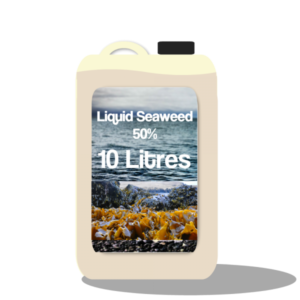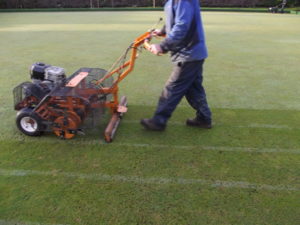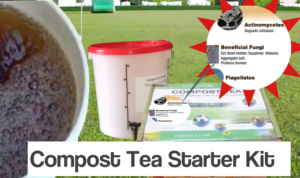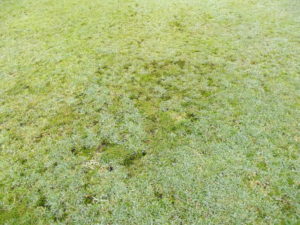Here are some recommended Greenkeeping tasks for December maintenance work for the Performance Bowling Greens Program.
Carrying out maintenance is of course dependent on the weather and underlying conditions. It has largely turned mild again, so I’m hearing a few reports from readers about fusarium and red thread outbreaks on greens. It’s important to keep an eye on these, especially fusarium as it can spread quickly in mild conditions. I’m not averse to getting the sprayer out to spot treat these outbreaks with fungicide if totally necessary. Blanket sprays and preventative sprays have no place in the Performance Greens Program, they do much more harm than good, so vigilance is important.
Here’s what you should ideally be getting on with this month:
Mowing (8mm and at least one cut this month)
Mowing should go on through the winter months when conditions allow. It’s important to keep the height of cut at 7 or 8mm throughout the winter period and not to let the grass get too long at any point. Not only does longer grass encourage disease, by creating a slightly warmer microclimate at the green surface, it also become coarser in texture.
Disease Control and Prevention (get some more Liquid Seaweed on)
 Greens that are still in the recovery phase probably will see occasional outbreaks of fusarium when the weather is mild and you shouldn’t be too complacent about these if your green is still thatchy, annual meadow grass dominated and/or apt to stay wet and soft at the surface.
Greens that are still in the recovery phase probably will see occasional outbreaks of fusarium when the weather is mild and you shouldn’t be too complacent about these if your green is still thatchy, annual meadow grass dominated and/or apt to stay wet and soft at the surface.
Spot treatments of fungicide are still recommended if needed.
Seaweed Liquid with its plethora of trace elements and natural plant inoculants is an essential helper in the soil in deep winter. Trace elements like Copper and Zinc are known to help grass plants fend off attacks from fusarium and other fungal pathogens and its bio-stimulant properties helps to keep the microbe population growing and active.
Dew/worm cast removal
Worm casts left on the surface or smeared into the turf with the mower become ideal seedbeds for weeds next year, so try to make sure you clear them using a switch or brush frequently when conditions allow.
We have over 50 species of earthworm and only 3 surface feeding species’ produce surface casts. They feed surface detritus, taking it back underground, helping to recycle it into soil. If you leave debris on the surface you will get more casting worms, so try to keep it clean.
Worm killers are mostly unavailable now thankfully, as they did more harm than good, so it comes down to suppressing worm activity if they are causing a nuisance. Light applications of sulphur liquid or lentils (granules) can have a good suppressant effect.
Deep slit tining
 This is the most important job throughout the winter months for any bowling green. By deep, I mean 125 to 200mm, with tines that can get in to the upper limit of this range being preferred.
This is the most important job throughout the winter months for any bowling green. By deep, I mean 125 to 200mm, with tines that can get in to the upper limit of this range being preferred.
If you’re starting this kind of maintenance for the first time, the tines might not penetrate to this depth due to hard, compacted layers in the soil, but persevere with twice a month slit tining and you will notice a gradual and incremental improvement in the depth achieved.
Compost Tea
 If the weather is mild and the green is able to take a pass of the sprayer it’s a good time to brew up and get some soil rejuvenating compost tea on your turf.
If the weather is mild and the green is able to take a pass of the sprayer it’s a good time to brew up and get some soil rejuvenating compost tea on your turf.
Some very interesting research from Sweden here on how soil microbes don’t slack off in winter, so the more you can do to encourage a strong soil food web, the better.
Tank mix the compost tea with Liquid Seaweed for an additional bio-stimulant boost to keep plants
More on Compost Tea here.
Moss
 Moss has been a continuing problem for many readers. Moss takes hold in any space that is left in the sward, so until your green has fully transitioned into a healthy, perennial dominated one, this will continue to be a problem, albeit decreasingly so.
Moss has been a continuing problem for many readers. Moss takes hold in any space that is left in the sward, so until your green has fully transitioned into a healthy, perennial dominated one, this will continue to be a problem, albeit decreasingly so.
Killing it at this time of year is of course counter productive as it simply creates space for more moss to come after it. If you still have lively looking moss on your green you can keep it under control until spring using some Chelated Liquid Iron.
Questions Please
Of course as always, if you have any questions comments or problems, please feel free to drop me a line.

John,
I noticed reference to lentils(granules) as worm suppressor. How would you use these?
Regards,
Chris
Hi Chris
Depending on your underlying conditions, soil chemistry/biology/thatch etc, Sulphur lentils at around 10g/m2 can be quite effective, but Liquid Sulphur is probably an easier option and less disruptive to the surface.
There are also other methods you can use to good effect, such as:
if the worms are a big problem then you should get good results using a mix of Chelated Liquid Iron, Liquid Copper and Salicylic Acid for suppression of casting activity.
If you want to try it out, here’s the mix:
1 litre of Chelated Liquid iron
70 ml of Liquid Copper
70 grams of Salicylic Acid (I can’t supply this, but you can buy it in powder form on ebay etc)
This should be diluted with about 60 litres of water and full amount applied to the green after tining to make holes for it to get into the soil.
You will probably have to dissolve the salicylic acid powder in fairly hot water before adding to the tank.
Another approach is to apply a heavy application of wetting agent on a dry day after making holes by sarrell rolling or mini tining. 3 litres of Hydroaid in 150 litres of water
Both of these approaches are working on the potential to irritate the worms by interrupting the mucus that covers their bodies. This makes them come to the surface where they can be picked off or left to desiccate, hence the need for a dry day.
Regards
John
Hi John, interesting solutions for the worm-cast problem which for us a BIG problem at the moment. We are swishing every other day and we remove 1000’s of casts every time, they make swishing tiring for many. An added problem is that when we mow (we have been mowing twice a month since the renovation) the residual mud from the casts clogs the front and back rollers and a cut that should take an hour takes 2 1/2 hours instead.
We have tried Purity which worked but takes forever, far to slow to do a whole green than is practical. We’ve also tried ClearCast which should stop them coming up but results from that aren’t great, lasts a few days and then we are back the cast of 1000’s again. So removing them is for us at the moment the better course and we might try the first of your solutions (iron, copper and acid) but how often would we be likely to need reapplying?
Hi John
Can I mix liquid seaweed in with compost tea and shoot.
Hi Ray
Yes you can
Regards
John
Hi john
Soil testing as I missed soil test at end of season is it a good time now or wait till spring for a soil test thanks in advance
Lawrence
Hi Lawrence
Now is as good a time as any
Regards
John
Hi John could you recommend a chemical which you recommend for fusarium we have a outbreak plus the price is our problem any advice appreciated regards Stuart
Hi Stuart
My approach is not to use fungicides if at all possible. More on disease management here.
Regards
John
Is it necessary to put down top soil on the green after it has been scarified?
Hi James
No it isn’t essential and sometimes detrimental. More on the subject here: https://bowls-central.co.uk/sand-top-dressing-friend-or-foe/
Regards
John